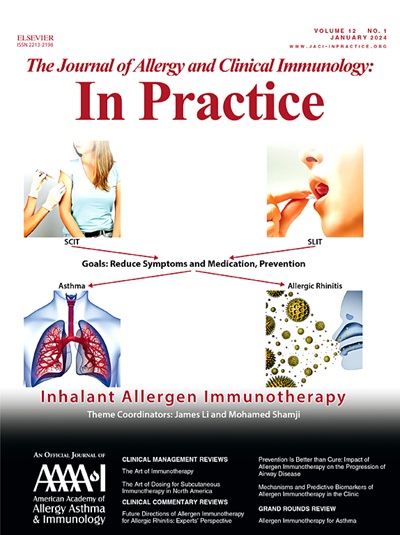Profiling Blood Hypereosinophilia in Patients on Dupilumab Treatment for Respiratory Conditions: A Real-Life Snapshot
IF 8.2
1区 医学
Q1 ALLERGY
Journal of Allergy and Clinical Immunology-In Practice
Pub Date : 2025-06-01
DOI:10.1016/j.jaip.2025.01.040
引用次数: 0
Abstract
Background
A transient and usually asymptomatic increase in blood eosinophil count (BEC) associated with dupilumab treatment has been described. Predicting factors related to the increase in BEC and the occurrence of symptoms are still poorly investigated.
Objective
To investigate frequency, timing, duration, clinical relevance, and potential predictors of the increase in BEC in a real-life multicenter cohort of patients affected by asthma and/or chronic rhinosinusitis with nasal polyps (CRSwNP) treated with dupilumab.
Methods
BEC and clinical conditions at baseline and every 3 months after the start of dupilumab treatment were assessed. Any adverse drug reaction was also recorded. Remission of dupilumab-associated eosinophilia was defined by follow-up BEC values <0.5 × 109 cells/L.
Results
Overall, 108 of 195 (55%) patients experienced an increased BEC after dupilumab initiation, but only 29 of 195 (14.9%) showed hypereosinophilia. BEC peak occurred 6 months after the start of treatment and resolved after 9 months (median time). The probability of developing hypereosinophilia was 3.3 times higher in patients with the baseline BEC between 0.5 × 109 and 1.5 × 109 cells/L. The occurrence of symptoms during BEC peak was higher in patients with comorbidities and in patients showing any increase in BEC.
Conclusions
In a real-life setting, dupilumab treatment in patients with asthma and/or CRSwNP was often associated with a transient increase in BEC, but hypereosinophilia rarely occurred. Onset of symptoms co-occurring with BEC peak was observed in a minority of subjects. BEC should not preclude dupilumab initiation or continuation but should be monitored for at least 8 months after treatment begins, particularly in the case of baseline eosinophilia/hypereosinophilia and/or comorbidities.
在dupilumab治疗呼吸系统疾病的患者中分析血液嗜酸性粒细胞增多症:一个真实的快照。
背景:杜匹单抗治疗可导致短暂且通常无症状的血嗜酸性粒细胞计数(BEC)升高。与BEC增加和症状发生相关的预测因素研究仍然很少。目的:研究dupilumab治疗的哮喘和/或慢性鼻窦炎合并鼻息肉(CRSwNP)患者的真实多中心队列中BEC增加的频率、时间、持续时间、临床相关性和潜在预测因素。方法:在基线和dupilumab治疗开始后每3个月评估BEC和临床情况。同时记录药物不良反应。dupilumab相关嗜酸性粒细胞增多症的缓解定义为随访BEC值< 0.5 x10 - 9细胞/L。结果:总体而言,195例患者中有108例(55%)在dupilumab开始治疗后出现BEC升高,但195例患者中只有29例(14.9%)出现嗜酸性粒细胞增多。BEC在治疗开始后6个月出现峰值,9个月后消退(中位时间)。基线BEC在0.5 - 1.5个细胞× 109L之间的患者发生嗜酸性粒细胞增多的可能性高出3.3倍。有合并症的患者和BEC升高的患者在BEC高峰期间的症状发生率较高。结论:在现实生活中,dupilumab治疗哮喘和/或CRSwNP患者通常与短暂性BEC升高相关,但很少发生嗜酸性粒细胞增多。在少数受试者中观察到与BEC峰值同时发生的症状。BEC不应排除dupilumab的启动或继续治疗,但应在治疗开始后至少监测8个月,特别是在基线嗜酸性粒细胞增多/嗜酸性粒细胞增多和/或合并症的情况下。
本文章由计算机程序翻译,如有差异,请以英文原文为准。
求助全文
约1分钟内获得全文
求助全文
来源期刊

Journal of Allergy and Clinical Immunology-In Practice
ALLERGYIMMUNOLOGY-IMMUNOLOGY
CiteScore
11.10
自引率
9.60%
发文量
683
审稿时长
50 days
期刊介绍:
JACI: In Practice is an official publication of the American Academy of Allergy, Asthma & Immunology (AAAAI). It is a companion title to The Journal of Allergy and Clinical Immunology, and it aims to provide timely clinical papers, case reports, and management recommendations to clinical allergists and other physicians dealing with allergic and immunologic diseases in their practice. The mission of JACI: In Practice is to offer valid and impactful information that supports evidence-based clinical decisions in the diagnosis and management of asthma, allergies, immunologic conditions, and related diseases.
This journal publishes articles on various conditions treated by allergist-immunologists, including food allergy, respiratory disorders (such as asthma, rhinitis, nasal polyps, sinusitis, cough, ABPA, and hypersensitivity pneumonitis), drug allergy, insect sting allergy, anaphylaxis, dermatologic disorders (such as atopic dermatitis, contact dermatitis, urticaria, angioedema, and HAE), immunodeficiency, autoinflammatory syndromes, eosinophilic disorders, and mast cell disorders.
The focus of the journal is on providing cutting-edge clinical information that practitioners can use in their everyday practice or to acquire new knowledge and skills for the benefit of their patients. However, mechanistic or translational studies without immediate or near future clinical relevance, as well as animal studies, are not within the scope of the journal.
 求助内容:
求助内容: 应助结果提醒方式:
应助结果提醒方式:


